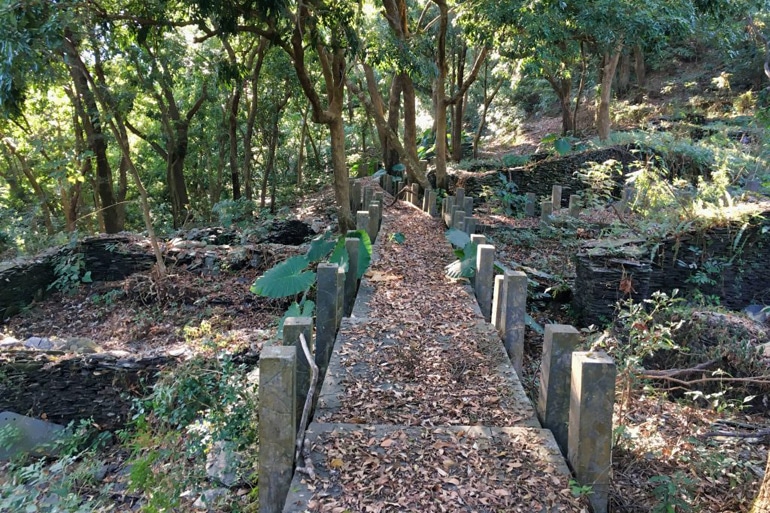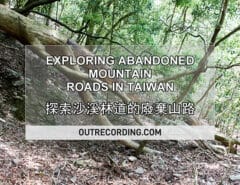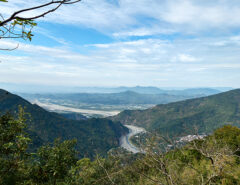This has to be one of the coolest places I’ve ever stumbled upon. With over 65 structures to explore, walkways and stairs throughout, and a back trail to a river, this abandoned village is something special to experience.
Ok, now that I got my tour guide spiel out of the way, let me tell the truth…the Terdreka (Teldrɨka) Settlement is friggen’ awesome! A few years ago I was trail riding in Maolin and followed a trail to the upper area of this old village. There were no signs or any indications that there was an entire village below. After some exploration I found it. And boy was I excited! I didn’t have time to stay long because it was getting late. So I had planned to come back someday for a better look. As it turns out, I came back many times but never went down to the village…until last week.
I arrived on a sunny morning. The drive up to the settlement is relatively easy. It’s concrete most of the way but I’m not sure I would drive a car unless it’s 4WD. There’s some farming activity on the mountain and one road goes all the way to the ridge. There’s a temple up there that is only accessible via this road, so you shouldn’t have to worry about the settlement suddenly being inaccessible. As you near the village you may see this newly-cleared bit of mountainside.

Prior to this trip, the land sometimes became quite overgrown here – so bad that I had to hike the rest of the way a couple times. But with farmers doing their thing here, it looks like the road will be clear at least to this point.
I believe the below picture was taken in this exact spot over three years ago.

A short drive past this point and you’ll reach the upper area of the settlement – or what I like to call “the parking lot”.
As you can see, there’s a house that’s designed to look somewhat similar to the houses that people used to live in here. It used to have a better looking roof.
But that roof caved in sometime in 2017.

This new roof looks ugly, but I suppose it will last longer.
Every time I visit, the “parking lot” is in various conditions. Sometimes nice and groomed like the above picture. Other times nearly overgrown.
The whole area looks like this…minus the 180 degree perspective.
I had planned to eat lunch here and didn’t want it to get too hot, so I left it on my bike and parked it in the gazebo in the upper area.

I’ve eaten under this gazebo several times over the years. I even weathered one particularly nasty thunderstorm here. It seems to be maintained from time to time so expect it to be here when you arrive.
Near the house is a stone sign.

To the right, between the sign and an old fence is the trail leading down to the main part of the village.

Follow it down…

…and take a left.
From here you can walk down and explore without my guidance. I only mention the way to get down because it’s not obvious from the upper area. From the parking lot there is also stairs that go up to another small area; you can see it in one of the above pictures. Somewhere up there is a grave site. I haven’t taken a look, so I can’t say who is buried there. But you can see it from the road on the way down if the land isn’t overgrown.
Getting back to the main village, after you make that left turn hopefully you won’t encounter overgrowth like I did.

I spent about 20 minutes hacking through this nasty stuff. It was mostly dead, which made it harder to cut through. AND…it had all these tiny thorns. So it was nearly impossible to push through without cutting. You may want to consider bringing a machete just in case.
The village itself is amazing to me. According to this website, the village is a cultural heritage site. In short, it has been here for a long time and inhabited up until 1940 when the occupants were forced to move to what is now Maolin village. This settlement is sometimes referred to as “old Maolin”. In total there are the remains of 65 houses. There is a stone map located somewhere in the village showing the general layout of the settlement.
I took this picture back in 2015. I don’t recall where it’s located, but I would guess in the parking lot area. I didn’t see it when I visited last week. It was either covered by overgrowth or was removed. I would put money on the former.
I decided to follow the walkways and stairs at first.
It was obvious it had been a while since anyone has been here.
In this section of the village there were a lot of what appear to be wild Poinsettia.
I can only guess at their origin. I’d like to think the Rukai who lived here–likely being Christian–planted them for religious reasons. But maybe they’re just a naturally occurring plant in this area. Apparently there are wild Poinsettia in Taiwan.
Walkways cross the settlement and stairs link them together.
The houses are situated between the walkways and scattered about in other directions. Only their foundations and a partial wall or two remain.
As you might have noticed in the last picture, there is a sign with a name on it by a house. Throughout the settlement there are signs just like that in or in front of a house. I had presumed they were the surnames of the former occupants. While going through my old pictures for this post, I found this one with names listed.
This is part of the stone map I mentioned earlier – on the right side. Several of the names correspond to the signs I saw. It’s not only a map of the layout of the settlement, but also a “directory” of sorts.
All of the names are painted on a piece of large marble floor tile; all in the same type of writing and paint. Just like this example:
When I first came here a few years ago, I don’t recall seeing any of these signs. I wasn’t looking for them, so it’s possible that they were there. But the condition of some of these signs lead me to believe they’re somewhat new. (new, as in a year or so old)
Judging by the exact same font and paint I thought maybe they were created for the whole village. But not all of the houses had them. There were more without signs than with them. Some looked almost new, while others looked old and moldy. Here are all the signs I found.
For some reason this caught my attention. Perhaps it was built for water drainage? I didn’t see anything else related to drainage, so I’m not certain. My only other guess is a bottomless pit. 🙂
There were a couple of these presumably for water storage.

The entire settlement is fascinating to walk through. It’s a step back in time for me. Not just the village itself, but things left behind by careless visitors. Like this unopened can of milk,


It definitely has some age to it. And no, I didn’t open it. hahaha…
One very interesting thing I found was this little cubbyhole in one house.

I contemplated not including this picture because of relic hunters. However, this place has been here for a long time. Anything of value would have been removed long ago. As I’ll explain later, I believe tourists used to come through here at least semi-regularly before typhoon Morakot. So I’m not worried that these are valuable in a monetary sense. But I should remind you that this settlement is listed as a cultural heritage site in Taiwan. I wouldn’t want to be on the receiving end of whatever penalties the government deems suitable for stealing at a place like this. Also, be careful while you walk around. You don’t want to get in trouble for accidentally destroying what’s left of these ruins.
My original plan was to explore the settlement a bit and then try and find an old communication road that google lists as going though here. However, when I got to the back of the village near this foundation of rocks that definitely wasn’t a house…
…I found a trail that I had thought would lead to the river far below. So I changed my plans and started following it. It was surprisingly in good shape. Most of the beginning section looked like this:

There were no trees or any plants growing on the path at the start. Rocks lined the edges, which is part of the reason why this path looks so good.

Along the way I encountered this structure. I can only guess what it was used for. It was too small and too far away from the rest of the village to be a house.
My quick progress to the river slowed when I hit some overgrowth.

At this point it turned into a kind of mini adventure for me. I was convinced that the trail led to the river. I was hoping it would come out someplace near the waterfall, but kind of doubted it would. In my mind, the aboriginals had used this trail to fetch water when the upper stream near the village went dry…or as a back exit in case invaders came. I have an overly-active imagination when I’m hiking alone. 🙂
But when I looked down, what I saw made me happy and disappointed at the same time.

Something like this could only have been built by the government. It meant that this used to be a tourist area, which was good because the trail would be easy to follow and would definitely go down to the river. But I was disappointed because it felt less like an adventure and more like a tourist hike. This took some of the excitement out of it, BUT…from what I read, this appears to have been built over the original trail that the aboriginals had used. Better than nothing.
It wasn’t long before I came to another gazebo.
I was quite surprised to find this at the time. It’s in bad shape but still usable. The floorboards at the opening are rotted through but the rest held me fine.

If you look at the gazebo picture above, you’ll see some blue barriers and the concrete road. I’ve driven by here many times and never noticed this gazebo.
The view from here is pretty good.
Looking down you can see a small footbridge. This is where it dawned on me where I was and where I would come out by the river. Before typhoon Morakot there was a concrete footpath to Meiya waterfall – 美雅谷瀑布. There’s a parking lot and bathroom you can still drive to not far from here. A short walk from there will take you to this bridge. A little ways past the bridge is where the path was destroyed by the typhoon. It has never been rebuilt and pretty much stopped tourists from coming out here. Hence, why this path and gazebo appear abandoned.
Keep hiking down past the gazebo. The way the land looks, I had thought the gazebo was on the edge of a switchback. It’s not. Just keep going down.
It starts getting a little worse past the gazebo but not terrible.

As I neared the bridge…
I ran into thicker and thicker overgrowth.

Eventually I lost the trail in a wall of overgrowth. I was really close to the bridge and didn’t want to turn back before reaching it, so I made my own trail by cutting down a rocky slope. I hung some orange ribbons to follow if you find the path is still overgrown.
Finally I made it to the bottom! Minus my break at the gazebo, it took me about an hour to get down.
After a brief rest and a look at an old sign that describes the village above…
…I made my way back up the mountain. But this time I wanted to try taking the original path up and not my makeshift path down the rocks. However, I was met with this…

No, not my ugly mug…but that wall of overgrowth. I had encountered this exact same thing on my last hike.
A little persistence and a strong arm later…

…and I made it through.
The rest of the ascent wasn’t anything special. I made it back to the settlement, explored a bit more, and then went back to my bike to cook my late lunch.
The view in the afternoon was great.
I never did get a chance to search for that communication road. That’ll be a good reason to come back again. 🙂
If you decide to visit, I would recommend doing a loop so you don’t need to drive up to the village. You could park at the parking lot at the old entrance to Meiya waterfall, here: 22.923565, 120.682776
Then hike to the bridge here: 22.925168, 120.684882 and make your way up to the village…and then back down on the main road to your vehicle.
Or..
From the parking lot, hike up the road to the top of the settlement…(Follow my GPX track)…and make your way down through the village to the bridge and then back to your vehicle.
This would be a more interesting way to do it for me. That way you’re not hiking up and down that same trail like I did. If you try it, do let me know how it went.
Date Hiked: 2018 December 20
GPX Track Download Instructions: Click the track on the map to see the download link















































![[Valid RSS]](http://outrecording.b-cdn.net/wp-content/uploads/2020/03/valid-rss-rogers.png)
2 Comments